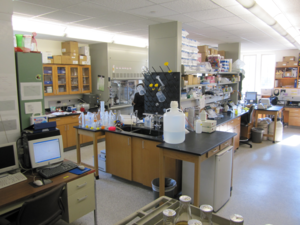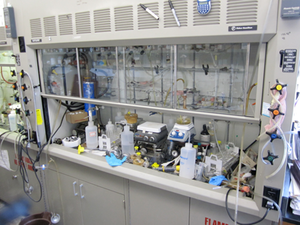 Chemistry Lab
Chemistry Lab
Notre Dame’s laboratory efficiency program recently passed a major milestone, having audited over a third of all campus research laboratories. Since the program’s inception in 2010, greeNDiscovery has saved tens of thousands of dollars’ worth of energy and avoided hundreds of thousands of pounds of CO₂ emissions. The program achieves these savings by working with research facilities across campus to minimize their carbon footprint.
Relative to comparably sized buildings, research labs across campus use roughly four times the electricity and two times the steam and chilled water. “While much of this energy is necessary in order to do research, we look for the areas where the energy is not being put to good use – where it’s just being wasted because of lack of awareness or obsolete equipment,” explained Rachel Novick of the Office of Sustainability, who developed the program. “We work with labs all across the College of Science and the College of Engineering, and 63 labs have participated to date.”
 Fume hood left open
Fume hood left open
During a half-hour tour around a facility, the greeNDiscovery team meters appliances and observes lab operations. “Of the 170 fume hoods that we have observed so far, 63 of those hoods were left open,” said sustainability intern Elizabeth Callam ’13, who coordinates the program. “That’s tens of thousands of dollars that can be saved each year through simple behavior change. By conducting an in-depth audit of each lab, we’re able to provide specific recommendations that are feasible and appropriate for that research group.”
In addition to keeping fume hoods closed, other simple ways to save energy include enabling computer sleep settings and turning off equipment when not in use. Decommissioning unneeded fume hoods and cold rooms are even bigger energy savers.
Labs also have the potential to receive new energy efficient appliances at no cost to the lab. “If an appliance is extremely inefficient, the savings in energy costs allow greeNDiscovery to provide a new, more efficient appliance using the Green Loan Fund,” said Novick. Seven labs have or will soon receive new appliances, including ovens, fridges, and freezers, through the program.

“Energy technology is changing so rapidly that facilities and laboratory equipment that were state-of-the-art just a few years ago can oftentimes be replaced with items that are far more energy efficient,” commented Dr. Paul Huber in the Department of Chemistry and Biochemistry, who received a replacement oven as well as a freezer in exchange for decommissioning his cold room.
greeNDiscovery also assists in hazardous materials abatement. Over a dozen labs have participated in a mercury thermometer exchange, receiving free spirit equivalents, and 15 additional labs are signed up for the next exchange. Other equipment using mercury in the labs is identified during audits and replacement options are pursued wherever possible.
Interested labs are encouraged to contact the Office of Sustainability at green@nd.edu for more information or to schedule an audit.